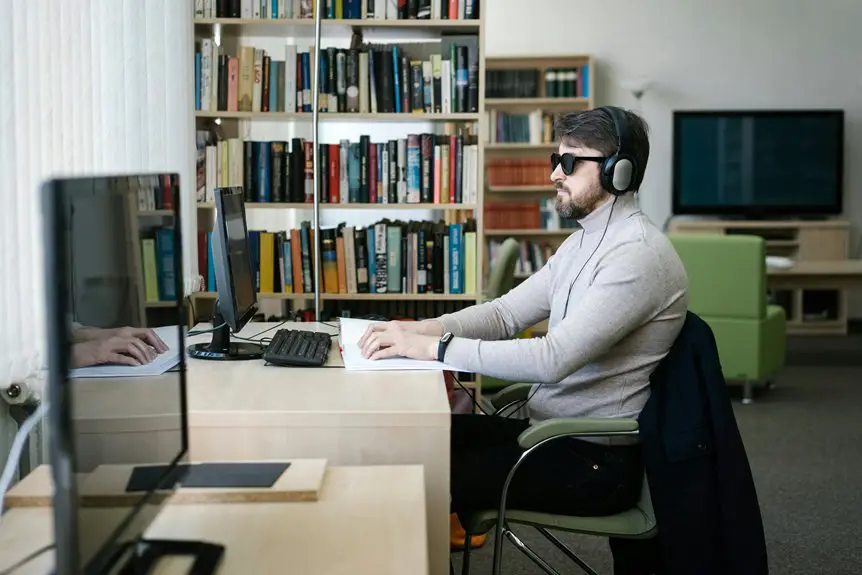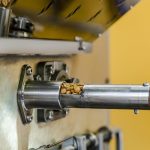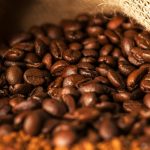When using a percolator, you’ll want to use 1 to 1.5 tablespoons of coarsely ground coffee per 6 ounces of water. For example, a 4-cup percolator needs about 4 tablespoons of coffee, while an 8-cup model requires 8 tablespoons. Using a medium-coarse grind helps prevent bitterness and clogging. Adjust the amount to match your taste, and avoid over-perking for the best flavor. Stick with these basics, and you’ll soon master perfect percolator coffee.
Table of Contents
Key Takeaways
- Use 1 to 1.5 tablespoons of coffee per 6 ounces of water for balanced strength and flavor.
- For a 4-cup percolator, measure 4 tablespoons of coffee; for 8 cups, use 8 tablespoons.
- Choose a medium-coarse grind to ensure proper water flow and avoid bitterness or clogging.
- Avoid overpacking coffee grounds to prevent bitter taste and ensure even extraction.
- Adjust coffee amount based on desired strength, but maintain consistent ratios for best results.
Understanding the Basics of Percolator Coffee Brewing
Although percolator coffee brewing might seem old-fashioned, it offers a unique way to extract bold flavors from your coffee grounds.
Percolator brewing may feel vintage, but it uniquely unlocks bold, rich flavors from your coffee grounds.
You’ll find that a percolator works by cycling boiling water through the coffee grounds repeatedly until it reaches the desired strength. Unlike drip machines, this process allows the water to pass over the grounds multiple times, intensifying the flavor.
You don’t have to worry about filters since the percolator uses a metal basket to hold the coffee, making cleanup easier. It’s important to use coarser grounds to prevent over-extraction and bitterness.
Once you get the hang of how the percolator works, you’ll appreciate the control it gives you over brewing time and strength, making each pot customizable to your taste.
Ideal Coffee-to-Water Ratio for Percolators
Finding the right coffee-to-water ratio is key to brewing a perfect pot in your percolator. Generally, aim for about 1 to 1.5 tablespoons of coarsely ground coffee per 6 ounces of water.
This balance guarantees your coffee isn’t too weak or overly bitter. If you prefer stronger coffee, lean toward 1.5 tablespoons; for a milder brew, stick closer to 1 tablespoon.
Keep in mind, the grind size matters—coarser grounds extract better without clogging the basket. Using this ratio consistently helps you achieve a smooth, flavorful cup every time.
Adjust slightly based on your taste preferences, but starting here gives you a reliable baseline for a satisfying percolator brew.
How to Measure Coffee for Different Percolator Sizes
To brew the best coffee with your percolator, you need to adjust the amount of coffee based on its size. For a 4-cup percolator, use about 4 tablespoons of coffee. If you have an 8-cup model, increase that to 8 tablespoons. For larger percolators, such as 12 cups, 12 tablespoons of coffee work well.
Always measure your coffee in tablespoons rather than scoops to keep it consistent. Use a standard tablespoon, and level it off to avoid overpacking.
Choosing the Right Grind Size for Percolator Coffee
Selecting the right grind size is essential for brewing great coffee in your percolator. If the grind is too fine, your coffee might turn bitter and over-extracted. Too coarse, and it’ll be weak and under-extracted.
Here’s how to choose the best grind size:
- Use a medium-coarse grind, similar to sea salt, to allow proper water flow.
- Avoid espresso or fine grinds; they clog the basket and cause bitterness.
- If you’re grinding beans yourself, use a burr grinder for consistent particle size.
- Experiment slightly with grind size to find your preferred strength and flavor balance.
Getting the grind right guarantees your percolator brews smooth, balanced coffee every time.
Adjusting Coffee Amount Based on Taste Preferences
You can easily tailor your coffee strength by adjusting the amount of grounds you use in your percolator.
If you prefer a mild brew, use less coffee; for a stronger taste, increase the quantity.
Finding the right balance lets you personalize every pot to match your flavor preferences.
Mild Vs Strong Brew
When you prefer a milder coffee, using less grounds in your percolator can help achieve a smoother taste without bitterness.
On the other hand, if you like a strong brew, adding more coffee grounds intensifies the flavor and caffeine kick. Balancing this is key to your perfect cup.
Here’s how to adjust:
- For mild coffee, start with 1 tablespoon of grounds per cup of water.
- For a stronger brew, increase to 1.5 or 2 tablespoons per cup.
- Avoid overfilling the basket, which can cause bitterness regardless of quantity.
- Experiment incrementally to find your ideal strength without wasting coffee.
Adjusting the grounds lets you control your coffee’s boldness every time you percolate.
Personalizing Coffee Strength
Finding the right amount of coffee grounds lets you tailor each pot to your taste. If you prefer a bolder cup, you can add a bit more coffee grounds without overwhelming the flavor. Conversely, if you like a lighter brew, using slightly less coffee helps keep it smooth and mild.
Don’t be afraid to experiment with small adjustments—try adding or subtracting a tablespoon of grounds per pot until you hit your ideal strength. Keep in mind that freshness and grind size also impact taste, so consider those factors as you personalize your brew.
Adjusting Grounds Quantity
Although adjusting the amount of coffee grounds might seem simple, it plays an essential role in achieving your desired flavor profile.
By tweaking the quantity, you control the strength and richness of your brew. Here’s how to adjust based on your taste:
- Start with the standard ratio: Use one tablespoon of grounds per cup of water.
- For a stronger cup, add an extra half tablespoon per cup.
- If you prefer milder coffee, reduce the grounds by half a tablespoon per cup.
- Experiment gradually: Adjust in small increments to avoid over- or under-extraction.
Keep track of your changes, so you can find the perfect balance that suits your palate every time.
Step-by-Step Guide to Brewing Coffee in a Percolator
Since brewing coffee in a percolator might seem tricky at first, you’ll want to follow a clear, step-by-step process to get the best flavor.
First, fill the percolator’s bottom chamber with fresh cold water up to the desired level. Next, place the coffee grounds basket on top and add the right amount of coffee grounds, based on your percolator size.
Secure the lid and place the percolator on your heat source. As the water heats, it will cycle through the grounds, extracting flavor.
Once you hear a consistent perking sound for about 7-10 minutes, remove the percolator from heat. Let it sit briefly to settle, then pour your freshly brewed coffee. Enjoy your perfectly brewed cup!
Common Mistakes to Avoid When Using a Percolator
Now that you know the basic steps to brew coffee in a percolator, it’s important to be aware of common mistakes that can affect your coffee’s taste and quality.
Avoid these pitfalls to get the best brew every time:
- Using too much coffee – Overloading your percolator leads to bitter, overpowering coffee. Stick to the recommended amount.
- Using the wrong grind size – Coarse grounds work best; fine grounds can clog the filter and create a muddy taste.
- Letting the coffee over-perk – Brewing too long causes bitterness. Watch the time and remove from heat promptly.
- Not cleaning the percolator regularly – Residue buildup affects flavor. Clean thoroughly after each use to keep your coffee tasting fresh.
Tips for Storing and Using Coffee to Maximize Freshness
To get the most flavor from your coffee, you need to store it properly and use it wisely.
Keep your coffee beans or grounds in an airtight container away from light, heat, and moisture. Avoid storing coffee in the fridge or freezer, as condensation can ruin the taste. Instead, choose a cool, dark pantry or cupboard.
Use your coffee within two weeks of opening the bag for peak freshness. Grind your beans just before brewing to preserve the natural oils and aromas.
When using a percolator, measure the coffee accurately and avoid letting it sit on heat too long, which can cause bitterness.
Frequently Asked Questions
Can I Use Flavored Coffee in a Percolator?
You can definitely use flavored coffee in a percolator. Just remember, the brewing process might intensify the flavors, so start with a small amount to see if you like the taste before making a full pot.
Does Water Temperature Affect Percolator Brewing Time?
Yes, water temperature does affect percolator brewing time. If your water’s too hot, it speeds up extraction but can cause bitterness. Cooler water slows brewing, giving you a milder flavor. You’ve got to balance it right.
How Do Altitude Changes Impact Percolator Coffee Brewing?
You’ll notice that higher altitudes lower water’s boiling point, so your percolator brews at cooler temps. This means your coffee might need a longer brew time to extract flavors properly and avoid weak taste.
Can I Use a Percolator on an Induction Cooktop?
You can use a percolator on an induction cooktop only if it has a magnetic base. If your percolator isn’t induction-compatible, you’ll need an adapter or a different heat source to brew your coffee properly.
What Are the Best Cleaning Methods for a Percolator?
You know what they say: “A clean house is a happy house.” You should regularly wash your percolator with warm, soapy water, descale it using vinegar, and rinse thoroughly to keep your coffee tasting fresh and pure.
- Is Percale the Same as Flannel? A Fabric Comparison - July 14, 2025
- Is Percale Softer Than Cotton? A Texture Showdown - July 14, 2025
- Is Percale or Sateen More Durable? A Longevity Comparison - July 14, 2025







